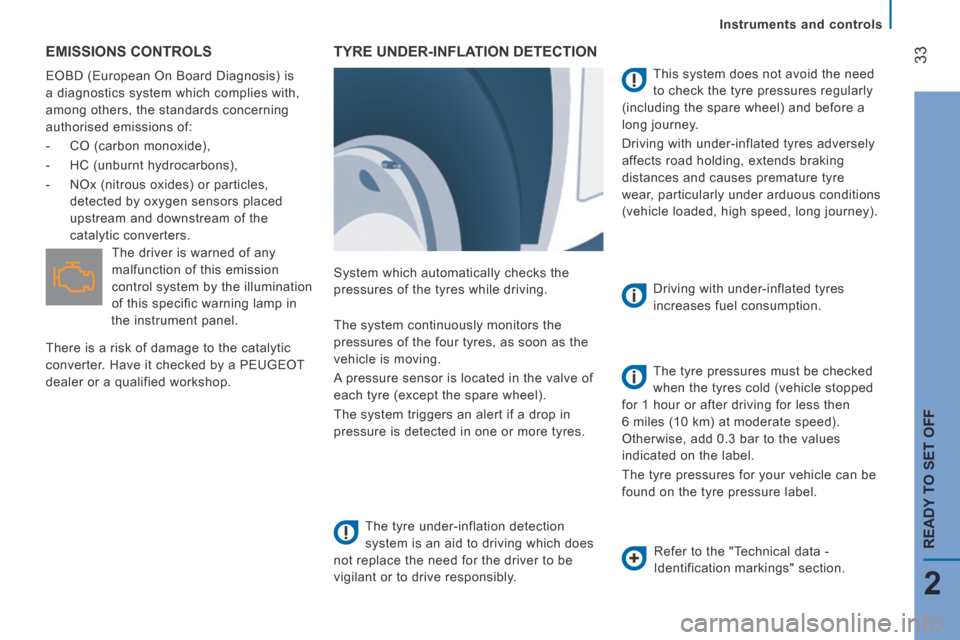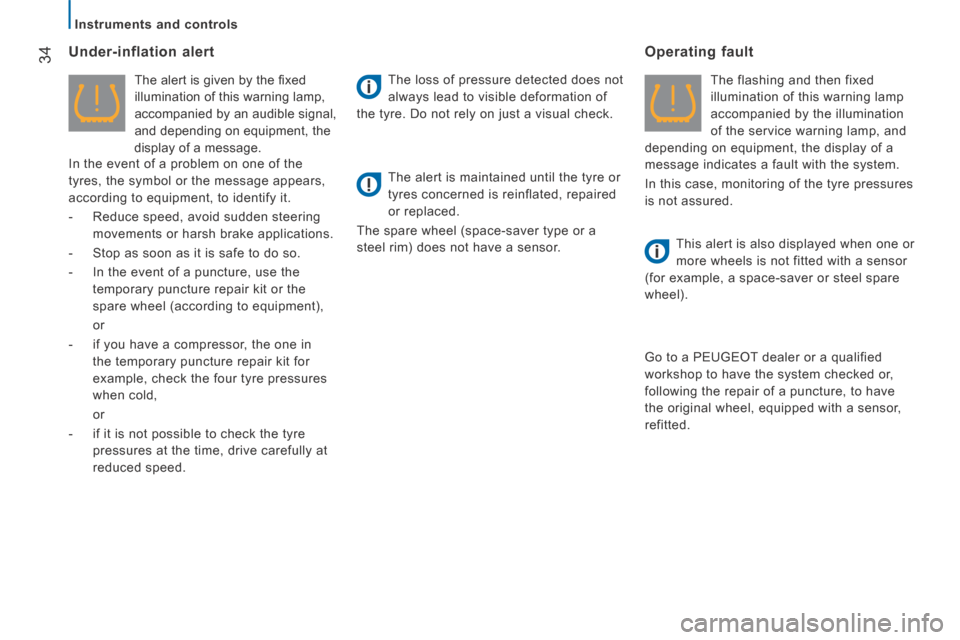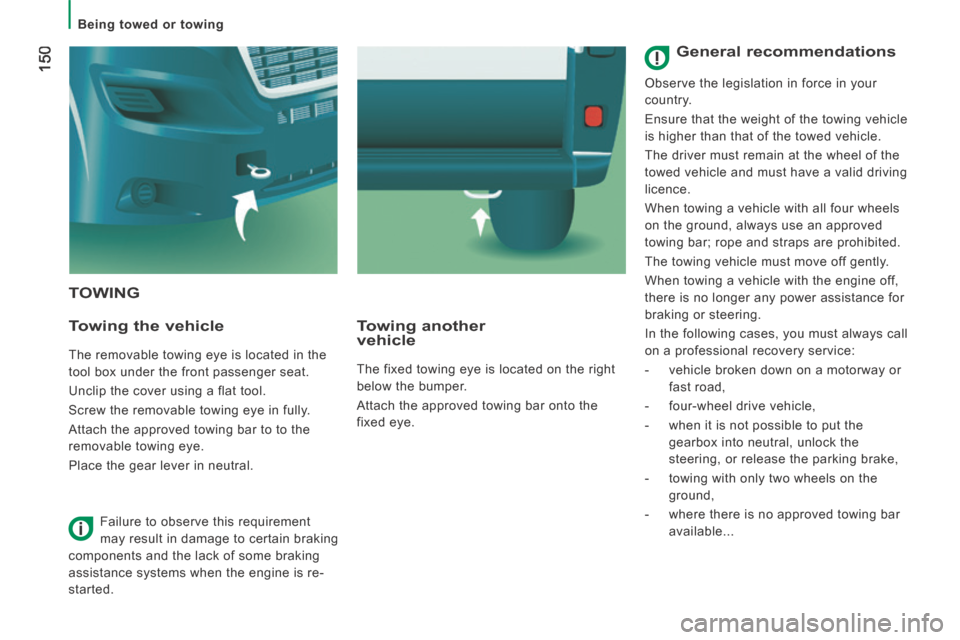Page 35 of 240

33
2
READY TO SET OFF
Instruments and controls
EMISSIONS CONTROLS
EOBD (European On Board Diagnosis) is
a diagnostics system which complies with,
among others, the standards concerning
authorised emissions of:
- CO (carbon monoxide),
- HC (unburnt hydrocarbons),
- NOx (nitrous oxides) or particles, detected by oxygen sensors placed
upstream and downstream of the
catalytic converters.
TYRE UNDER-INFLATION DETECTION
System which automatically checks the
pressures of the tyres while driving.
The tyre under-inflation detection
system is an aid to driving which does
not replace the need for the driver to be
vigilant or to drive responsibly. This system does not avoid the need
to check the tyre pressures regularly
(including the spare wheel) and before a
long journey.
Driving with under-inflated tyres adversely
affects road holding, extends braking
distances and causes premature tyre
wear, particularly under arduous conditions
(vehicle loaded, high speed, long journey).
Driving with under-inflated tyres
increases fuel consumption.
The system continuously monitors the
pressures of the four tyres, as soon as the
vehicle is moving.
A pressure sensor is located in the valve of
each tyre (except the spare wheel).
The system triggers an alert if a drop in
pressure is detected in one or more tyres. The tyre pressures must be checked
when the tyres cold (vehicle stopped
for 1 hour or after driving for less then
6 miles (10 km) at moderate speed).
Otherwise, add 0.3 bar to the values
indicated on the label.
The tyre pressures for your vehicle can be
found on the tyre pressure label.
The driver is warned of any
malfunction of this emission
control system by the illumination
of this specific warning lamp in
the instrument panel.
There is a risk of damage to the catalytic
converter. Have it checked by a PEUGEOT
dealer or a qualified workshop.
Refer to the "Technical data -
Identification markings" section.
Page 36 of 240

34
Instruments and controls
Under-inflation alert
The alert is given by the fi xed
illumination of this warning lamp,
accompanied by an audible signal,
and depending on equipment, the
display of a message.
In the event of a problem on one of the
tyres, the symbol or the message appears,
according to equipment, to identify it.
- Reduce speed, avoid sudden steering
movements or harsh brake applications.
- Stop as soon as it is safe to do so.
- In the event of a puncture, use the temporary puncture repair kit or the
spare wheel (according to equipment),
or
- if you have a compressor, the one in the temporary puncture repair kit for
example, check the four tyre pressures
when cold,
or
- if it is not possible to check the tyre pressures at the time, drive carefully at
reduced speed. The loss of pressure detected does not
always lead to visible deformation of
the tyre. Do not rely on just a visual check.
The alert is maintained until the tyre or
tyres concerned is reinflated, repaired
or replaced.
The spare wheel (space-saver type or a
steel rim) does not have a sensor.
Operating fault
The flashing and then fixed
illumination of this warning lamp
accompanied by the illumination
of the service warning lamp, and
depending on equipment, the display of a
message indicates a fault with the system.
In this case, monitoring of the tyre pressures
is not assured.
This alert is also displayed when one or
more wheels is not fitted with a sensor
(for example, a space-saver or steel spare
wheel).
Go to a PEUGEOT dealer or a qualified
workshop to have the system checked or,
following the repair of a puncture, to have
the original wheel, equipped with a sensor,
refitted.
Page 148 of 240
146
Puncture
Removing the wheel to be repaired
- Remove the trim using the screwdriver F
as a lever.
- Release the bolts using the wheelbrace E .
- Position the jack C at one of the four
locations provided on the underbody
near the wheels.
Spare wheel
The spare wheel retaining bolt is located
below the bumper on the right.
- Turn the bolt using the long socket A
and the ratchet wrench B to release the
wheel.
- Turn to the locking point, indicated by an increase in the force required for the
manoeuvre. - Take out the spare wheel using the
wrench.
- Unscrew the handle G and remove the
support H .
- Release the spare wheel and place it near the wheel to be changed.
Page 152 of 240

150
Being towed or towing
TOWING
Towing the vehicle
The removable towing eye is located in the
tool box under the front passenger seat.
Unclip the cover using a flat tool.
Screw the removable towing eye in fully.
Attach the approved towing bar to to the
removable towing eye.
Place the gear lever in neutral.
Towing another vehicle
The fixed towing eye is located on the right
below the bumper.
Attach the approved towing bar onto the
fixed eye.
Failure to observe this requirement
may result in damage to certain braking
components and the lack of some braking
assistance systems when the engine is re-
started.
General recommendations
Observe the legislation in force in your
country.
Ensure that the weight of the towing vehicle
is higher than that of the towed vehicle.
The driver must remain at the wheel of the
towed vehicle and must have a valid driving
licence.
When towing a vehicle with all four wheels
on the ground, always use an approved
towing bar; rope and straps are prohibited.
The towing vehicle must move off gently.
When towing a vehicle with the engine off,
there is no longer any power assistance for
braking or steering.
In the following cases, you must always call
on a professional recovery service:
- vehicle broken down on a motorway or fast road,
- four-wheel drive vehicle,
- when it is not possible to put the gearbox into neutral, unlock the
steering, or release the parking brake,
- towing with only two wheels on the ground,
- where there is no approved towing bar available...